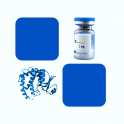
- Remove this product from my favorite's list.
- Add this product to my list of favorites.
Products
Newsletter
 |  |  |  |  |  |

Background
Low-Density Lipoprotein (LDL) Receptor is also known as LDLR, FH, FHC, LDLCQ2, and is a mosaic protein of ~840 amino acids (after removal of signal peptide) that mediates the endocytosis of cholesterol-rich LDL. It is a cell-surface receptor that recognizes the apoprotein B100 which is embedded in the phospholipid outer layer of LDL particles. The receptor also recognizes the apoE protein found in chylomicron remnants and VLDL remnants (IDL). It belongs to the Low density lipoprotein receptor gene family. LDL receptor complexes are present in clathrin-coated pits (or buds) on the cell surface, which when bound to LDL-cholesterol via adaptin, are pinched off to form clathrin-coated vesicles inside the cell. This allows LDL-cholesterol to be bound and internalized in a process known as endocytosis and prevents the LDL just diffusing around the membrane surface. This occurs in all nucleated cells (not erythrocytes), but mainly in the liver which removes ~70% of LDL from the circulation. Synthesis of receptors in the cell is regulated by the level of free intracellular cholesterol; if it is in excess for the needs of the cell then the transcription of the receptor gene will be inhibited. LDL receptors are translated by ribosomes on the endoplasmic reticulum and are modified by the Golgi apparatus before travelling in vesicles to the cell surface. LDL is directly involved in the development of atherosclerosis, due to accumulation of LDL-cholesterol in the blood. Atherosclerosis is the process responsible for the majority of cardiovascular diseases.
Source
Recombinant Cynomolgus LDL Receptor protein, His Tag (LDR-C5222) is expressed from human 293 cells (HEK293). It contains AA Ala 22 - Gly 788 (Accession # XP_005588053.1).
Predicted N-terminus: Ala 22
Molecular Characterization
This protein carries a polyhistidine tag at the C-terminus.
The protein has a calculated MW of 86.8 kDa. The protein migrates as 135-155 kDa under reducing (R) condition (SDS-PAGE) due to glycosylation.
Endotoxin
Less than 1.0 EU per μg by the LAL method.
Purity
>95% as determined by SDS-PAGE.
Formulation
Lyophilized from 0.22 μm filtered solution in PBS, pH7.4. Normally trehalose is added as protectant before lyophilization.
Reconstitution
Please see Certificate of Analysis for specific instructions.
For best performance, we strongly recommend you to follow the reconstitution protocol provided in the CoA.
Storage
For long term storage, the product should be stored at lyophilized state at -20°C or lower.
Please avoid repeated freeze-thaw cycles.
Please avoid repeated freeze-thaw cycles.
This product is stable after storage at:
-20°C to -70°C for 12 months in lyophilized state;
-70°C for 3 months under sterile conditions after reconstitution.
Bioactivity
Please refer to product data sheet.
(1) "Dyslipidemia prevalence in non-obese non-diabetic patients with obstructive sleep apnea: does sex matter?"
Basoglu, Tasbakan, Kayikcioglu
J Clin Sleep Med (2023)
(2) "Comparison between the direct method and Friedewald's formula for the determination of low-density lipoprotein cholesterol serum levels in horses"
Ribeiro, Ribeiro, Cota et al
J Equine Vet Sci (2023)
(3) "The Impact of Low-Density Lipoprotein Equation Changes on Cholesterol Treatment in Canada"
Zhao, Hegele
CJC Open (2023) 5 (1), 37-42
Showing 1-3 of 9739 papers.
Follow us